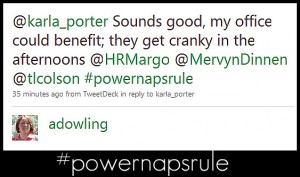 There's a grassroots movement going on in the twittersphere to amend HR policy to include power naps. You know, to calm the crankies. One simply innocuous tweet about having just taken a nap spurred a hashtagged thread of conversation that got me thinking..
There's a grassroots movement going on in the twittersphere to amend HR policy to include power naps. You know, to calm the crankies. One simply innocuous tweet about having just taken a nap spurred a hashtagged thread of conversation that got me thinking..
You've heard the stories about employees "caught" napping on company time. Everything from being laughed at to a verbal lashing or actual administrative discipline ensue.
But, HRecruiting Alert recently reported on Pew research indicating that 33% of those earning six figures nap regularly on the clock. And apparently there is a whole niche industry around the practice. There's a PowerNap NapMachine which touts 3 hours of deep sleep in just 20 minutes and a Power Nap Kit with versions for teens, college students and adults.
What about the time honored Latin American tradition of the siesta? It's actually a pretty cool concept. Work days are split into 2 parts with a 2 hour break in the middle. Go home, have lunch, take a nap, see your family.... Of course it might not work well for long distance commuters. But, progressive companies could have quiet rooms.
According to the National Sleep Foundation, "more than 85% of mammalian species are polyphasic sleepers, meaning that they sleep for short periods throughout the day. Humans are part of the minority of monophasic sleepers, meaning that our days are divided into two distinct periods, one for sleep and one for wakefulness." They go on to say that it's is not clear that this is the natural sleep pattern of humans. I don't put myself above other mammals, especially when it comes to napping.
What about the stigmas attached to napping like laziness, a lack of ambition, and low standards or that it's only for children, the sick and the elderly? With a whole foundation that recognizes the benefits it seems that napping just needs a better PR campaign.
Some of todays employers permit napping at work. More than one third of Americans (34%) say that their workplace permits napping during breaks at work, with 16 percent reporting that their employer even provides a place for them to nap. An additional 26 percent say they would nap on a break at work if their employer were to allow it.
If you work in one of the 66% of workplaces that don't permit napping on the clock I want to help. Here's a sample Workplace Napping Policy I devised. It can be customized to meet the needs of your workplace. If you're not in a position to implement company policy you can forward this post to whomever is and request they review it for consideration in your workplace.
Workplace napping is a company benefit that recognizes that similar to diet and exercise, sleep needs to be an integral element of a healthy lifestyle. The impact of not getting good sleep is far reaching and has Americans compromising their productivity, safety, health and relationships both on the job and at home.
Employees are provided the opportunity to nap during work hours on their paid break without fear of being stigmatized as lazy, unambitious or lacking in standards. Napping is permitted in areas where the work of others will not be affected such as private offices, break areas and quiet rooms. It is the responsibility of employees to monitor their nap time via personal alarms to ensure they do not go over their allotted break time.
If you don't now how to power nap wikiHow offers some great tips.
National Napping Day is each year the Monday after Daylight Savings kicks in. It will be celebrated March 9, 2010.
I will be celebrating.
Is napping allowed where you work? if not, how do you manage to nap when you need it?
Leave a Reply